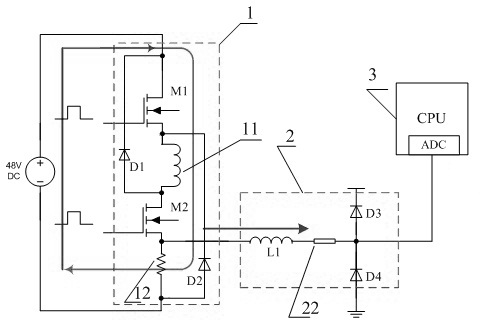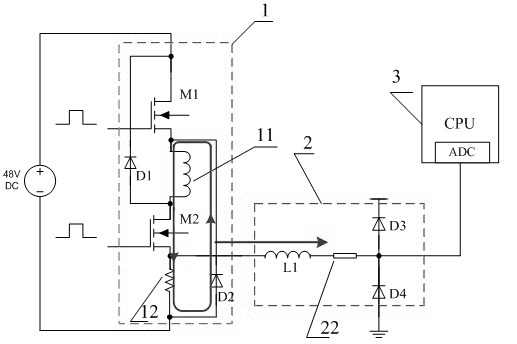Sampling circuit and sampling method for phase winding current of switched reluctance motor
A technology of switched reluctance motor and sampling circuit, which is applied in the direction of electronic commutator, etc., can solve the problems of Hall sensor phase difference, temperature characteristics and frequency response characteristics, and achieve real-time sampling, high sensitivity and low price.
- Summary
- Abstract
- Description
- Claims
- Application Information
AI Technical Summary
Problems solved by technology
Method used
Image
Examples
Embodiment 1
[0020] Example 1: In figure 1 Based on the circuit configuration shown, as figure 2 As shown, when both the first MOS transistor M1 and the second MOS transistor M2 are turned on, the switched reluctance motor is in the excitation mode. At this time, the externally provided 48V DC drive power supply, the first MOS transistor M1, and the motor A-phase winding 11 , the second MOS tube M2, and the manganin resistor 12 form a current loop. The excitation voltage signal at both ends of the manganin resistor 12 is transmitted from the connection point between the source of the second MOS transistor M2 and the manganin resistor to the filter circuit 2 in the direction indicated by the arrow in the figure, and then passed through the inductance L1 and the zero-ohm resistor 22 to the The ADC of the processor 3 implements resistance sampling of the winding current. The inductance L1 in the filter loop 2 can effectively filter out high-frequency signals, and the parasitic inductance p...
Embodiment 2
[0021] Example 2: In figure 1 Based on the circuit configuration shown, as image 3 As shown, when the first MOS transistor M1 is turned off and the second MOS transistor M2 is turned on, the switched reluctance motor is in the freewheeling mode. At this time, the A-phase winding 11, the second diode D2, the manganin resistor 12, and the second The two MOS transistors M2 form a current loop. The freewheeling voltage signal at both ends of the manganin resistor 12 is transmitted from the connection point between the source of the second MOS transistor M2 and the manganin resistor to the filter circuit 2 in the direction indicated by the arrow in the figure, and then passed through the inductance L1 and the zero-ohm resistor 22 to be transmitted to the ADC31 of the processor 3 to realize the resistance sampling of the winding current. The inductance L1, the zero-ohm resistor 22, the third diode D3 and the fourth diode D4 in the filter circuit 2 still have the same functions as...
Embodiment 3
[0022] Example 3: In figure 1 Based on the circuit configuration shown, as image 3As shown, when the first MOS transistor M1 and the second MOS transistor M2 are cut off at the same time, the motor is in the recirculation mode. At this time, the first diode D1, the A-phase winding 11, the second diode D2 and the external 48V DC power supply A loop is formed. At this time, the current in the winding flows back to feed the DC power supply. No current flows through the zero-ohm resistor 22, and the processor 3 cannot obtain the corresponding current signal. However, since the motor at this time has completed the commutation from phase A to phase B, that is, it has switched to the sampling, processing and analysis of the current signal of phase B in the current sampling circuit of phase B, and the post-processing algorithm of the system has also been completed at this time. The value of the A-phase current signal is no longer needed, so it can fully meet the current sampling req...
PUM
 Login to View More
Login to View More Abstract
Description
Claims
Application Information
 Login to View More
Login to View More - R&D
- Intellectual Property
- Life Sciences
- Materials
- Tech Scout
- Unparalleled Data Quality
- Higher Quality Content
- 60% Fewer Hallucinations
Browse by: Latest US Patents, China's latest patents, Technical Efficacy Thesaurus, Application Domain, Technology Topic, Popular Technical Reports.
© 2025 PatSnap. All rights reserved.Legal|Privacy policy|Modern Slavery Act Transparency Statement|Sitemap|About US| Contact US: help@patsnap.com



